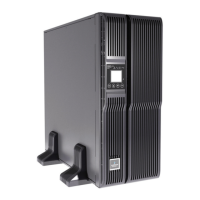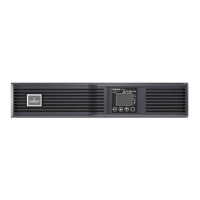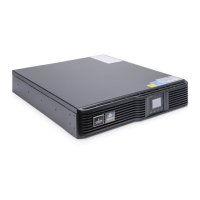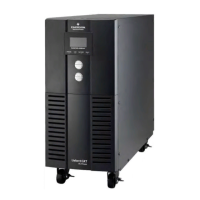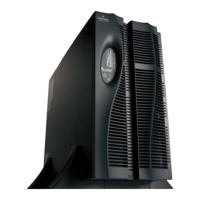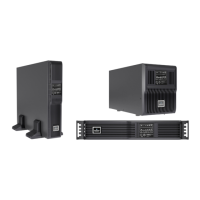Do you have a question about the Emerson Liebert GXT4-5000RT230 and is the answer not in the manual?
Filters surges, EMI, and RFI to protect equipment from line disturbances.
Converts AC to DC, improving input current waveform and UPS efficiency.
Converts DC to precise, regulated sinewave AC power for connected equipment.
Regulates utility power to float charge the batteries continuously.
Adjusts battery voltage to the optimal level for the inverter's operation.
Utilizes valve-regulated, nonspillable lead-acid batteries for power backup.
Provides an alternate path for utility power in case of UPS malfunction.
Describes the main cabinet housing the UPS components and electronics.
Details the box containing the UPS input circuit breaker and output receptacles.
Explains the location and connection of the internal battery packs within the UPS.
Guides on installing the main UPS unit, either in a tower or rack configuration.
Step-by-step instructions for setting up the UPS in a vertical tower orientation.
Instructions for installing the UPS into a standard equipment rack.
Details on using the optional adjustable rack-mount kit for installation.
Procedures for connecting and installing optional external battery cabinets for extended runtime.
Explains how to connect the UPS to the power source and load, including breaker details.
Details on wiring and connections for the power distribution box.
Specifics on connecting input/output wiring via terminal blocks.
Lists features available for custom UPS configuration via software.
Outlines the necessary software, hardware, and computer for configuration.
Explains the function and color of various LED status indicators on the UPS.
Describes the purpose and operation of the physical control buttons on the UPS panel.
Covers the LCD display, including startup, ON, and default screens.
Navigational menu for accessing UPS status, configuration, and control functions.
Lists system prompts and their meanings for user interaction.
Details various warning messages and their corresponding conditions.
Lists all fault messages, their causes, and the UPS response.
Pre-operation checks to ensure the UPS is correctly connected and ready.
Step-by-step guide for the initial power-up and electrical verification of the UPS.
Procedure to initiate a manual test of the UPS battery performance.
Instructions on how to transfer the UPS to bypass mode for maintenance or troubleshooting.
Steps for safely powering down the UPS unit.
Procedures for disconnecting the UPS from the main power source.
Explains how to use the maintenance bypass mode for servicing.
Details on configuring the UPS for specific IT power system requirements.
Overview of the communication port and its signal assignments.
Describes the terminal block, its pins, and their functions for shutdown signals.
How to use terminal pins for remote or local UPS shutdown.
How to initiate shutdown when the UPS is on battery power.
Information on optional communication cards for network monitoring and control.
Details on using MultiLink software for UPS monitoring and control.
How to connect and use the Remote Emergency Power Off (REPO) feature.
Step-by-step guide for safely replacing the internal UPS battery pack.
Information on battery charging and maintenance for optimal lifespan.
Safety precautions to follow during UPS operation and maintenance.
Recommended procedures for periodically checking the UPS operational status.
Guidelines for testing UPS functions like bypass, operation modes, and battery tests.
Filters surges, EMI, and RFI to protect equipment from line disturbances.
Converts AC to DC, improving input current waveform and UPS efficiency.
Converts DC to precise, regulated sinewave AC power for connected equipment.
Regulates utility power to float charge the batteries continuously.
Adjusts battery voltage to the optimal level for the inverter's operation.
Utilizes valve-regulated, nonspillable lead-acid batteries for power backup.
Provides an alternate path for utility power in case of UPS malfunction.
Describes the main cabinet housing the UPS components and electronics.
Details the box containing the UPS input circuit breaker and output receptacles.
Explains the location and connection of the internal battery packs within the UPS.
Guides on installing the main UPS unit, either in a tower or rack configuration.
Step-by-step instructions for setting up the UPS in a vertical tower orientation.
Instructions for installing the UPS into a standard equipment rack.
Details on using the optional adjustable rack-mount kit for installation.
Procedures for connecting and installing optional external battery cabinets for extended runtime.
Explains how to connect the UPS to the power source and load, including breaker details.
Details on wiring and connections for the power distribution box.
Specifics on connecting input/output wiring via terminal blocks.
Lists features available for custom UPS configuration via software.
Outlines the necessary software, hardware, and computer for configuration.
Explains the function and color of various LED status indicators on the UPS.
Describes the purpose and operation of the physical control buttons on the UPS panel.
Covers the LCD display, including startup, ON, and default screens.
Navigational menu for accessing UPS status, configuration, and control functions.
Lists system prompts and their meanings for user interaction.
Details various warning messages and their corresponding conditions.
Lists all fault messages, their causes, and the UPS response.
Pre-operation checks to ensure the UPS is correctly connected and ready.
Step-by-step guide for the initial power-up and electrical verification of the UPS.
Procedure to initiate a manual test of the UPS battery performance.
Instructions on how to transfer the UPS to bypass mode for maintenance or troubleshooting.
Steps for safely powering down the UPS unit.
Procedures for disconnecting the UPS from the main power source.
Explains how to use the maintenance bypass mode for servicing.
Details on configuring the UPS for specific IT power system requirements.
Overview of the communication port and its signal assignments.
Describes the terminal block, its pins, and their functions for shutdown signals.
How to use terminal pins for remote or local UPS shutdown.
How to initiate shutdown when the UPS is on battery power.
Information on optional communication cards for network monitoring and control.
Details on using MultiLink software for UPS monitoring and control.
How to connect and use the Remote Emergency Power Off (REPO) feature.
Step-by-step guide for safely replacing the internal UPS battery pack.
Information on battery charging and maintenance for optimal lifespan.
Safety precautions to follow during UPS operation and maintenance.
Recommended procedures for periodically checking the UPS operational status.
Guidelines for testing UPS functions like bypass, operation modes, and battery tests.
| Form Factor | Tower |
|---|---|
| Weight | 95 lbs (43.1 kg) |
| Topology | Double Conversion Online |
| Output Voltage Regulation | ±1% |
| Output Waveform | Sine Wave |
| Input Power Factor | ≥ 0.99 |
| Relative Humidity | 0-95% non-condensing |
| Input Voltage | 230 VAC |
| Output Voltage | 230 VAC |
| Battery Type | Sealed Lead Acid |
| Runtime | Varies by load |
| Output Frequency | 50/60 Hz ± 0.1% |
| Input Voltage Range | 160V - 288V |
| Typical Recharge Time | 3-4 hours |
| Communication Ports | USB, RS-232, SNMP |
| Operating Temperature | 0°C to 40°C (32°F to 104°F) |
| Storage Temperature | -15°C to 45°C (5°F to 113°F) |
| Audible Noise | <55 dB at 1 meter |
